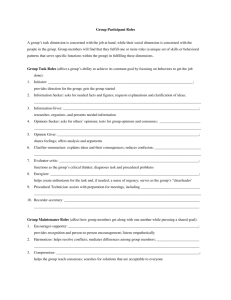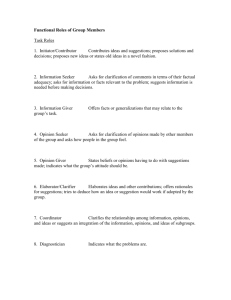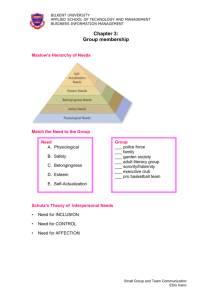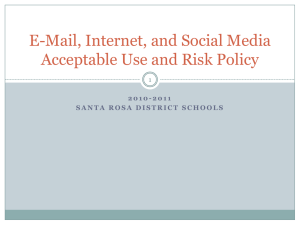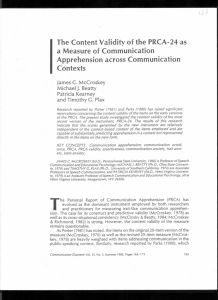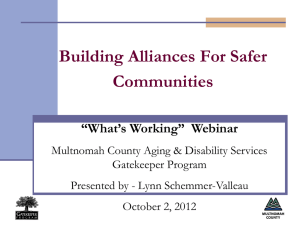Chapter 4: Confidence in Groups
advertisement
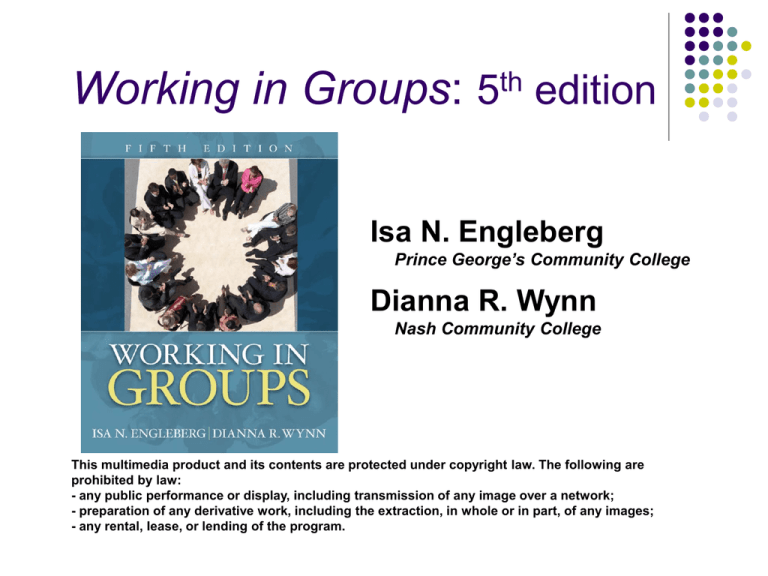
Working in Groups: 5th edition Isa N. Engleberg Prince George’s Community College Dianna R. Wynn Nash Community College This multimedia product and its contents are protected under copyright law. The following are prohibited by law: - any public performance or display, including transmission of any image over a network; - preparation of any derivative work, including the extraction, in whole or in part, of any images; - any rental, lease, or lending of the program. Chapter 3: Group Membership Maslow’s Hierarchy of Needs Match the Need to the Group Need A. B. C. D. E. Physiological Safety Belongingness Esteem Self-Actualization Group ___ police force ___ family ___ garden society ___ adult literacy group ___ sorority/fraternity ___ executive club ___ pro basketball team Schutz’s Theory of Interpersonal Needs Fundamental Interpersonal Relationship Orientation (FIRO) Need for INCLUSION Need for CONTROL Need for AFFECTION Inclusion Needs “I need to feel accepted by the group.” “I feel accepted by the group.” Social Member “I don’t feel accepted by or involved in the group.” “I won’t participate much in group discussions.” Undersocial Member “I try to gain the group’s attention.” Oversocial Member Control Needs “I need to feel influential and important.” “Others respect me.” Democratic Member “I don’t have influence in the group.” “I just do what I am told.” Abdicrat “I try to dominate the group.” Autocrat Affection Needs “I need to feel that others like me.” “I feel that others like me and if they don’t, that’s OK.” “I’m not sure that others like me.” “I avoid friendships “I confide in and with other members.” try to become very close with others.” Personal Member Underpersonal Overpersonal Member Member Group Role Categories Group Task Roles 1. 2. 3. 4. 5. 6. Initiator Information Seeker CoordinatorChairperson Information Giver Opinion Seeker Opinion Giver ClarifierSummarizer 8. ImplementerCompleter 9. Evaluator-Critic 10. Energizer 11. Procedural Technician 12.Recorder-Secretary 7. Group Maintenance Roles 1. 2. 3. 4. 5. 6. 7. Encourager-Supporter Harmonizer Compromiser Tension Releaser Gatekeeper Observer-Interpreter Teamworker-Follower Identify Roland’s Role(s) Roland expresses his personal opinions and feelings. He summarizes group progress and draws conclusions. When group members argue, he mediates conflict and paraphrases what others say. ___ Compromiser ___ Gatekeeper ___ Harmonizer ___ Observer-Interpreter ___ Evaluator ___ Clarifier-Summarizer ___ Energizer ___ Opinion Giver ___ Recognition Seeker ___ Follower Self-Centered Roles 1. 2. 3. 4. 5. 6. 7. 8. Aggressor Blocker Dominator Recognition Seeker Clown Deserter Confessor Special Interest Pleader PowerPoint Quiz “Maria, we haven’t heard from you yet and want to make sure that everyone gets a chance to weigh in on this issue” would most likely be said by a group member assuming the role of a(n): a. Harmonizer b. Standard monitor c. Observer-interpreter d. Gatekeeper e. Procedural technician Group and Member Confidence Members who lack confidence are less likely to share what they know or voice their opinions. Confident members are more effective group members. Confident groups are more likely to succeed. Communication Apprehension “An individual’s level of fear or anxiety associated with either real or anticipated communication with another person or persons.” About 20 percent of the general population experiences very high levels of communication apprehension. Virginia P. Richmond and James C. McCroskey, Communication: Apprehension, Avoidance, and Effectiveness How Confident Are You? Are you comfortable participating in group discussions? Do you like to get involved in group discussions? Are you afraid to express yourself at meetings? Are you relaxed when answering questions at a meeting? High Apprehensives Avoid participation Talk less often Agree with others Smile or giggle inappropriately Fidget Use awkward fillers phrases, e.g. “uh” Have difficulty following a discussion Low Apprehensives Initiate discussion Speak more often Assert themselves Are more likely to become leaders Choose when to speak or be silent Appear confident May dominate discussion Strategies for Coping with Communication Apprehension Strategy: Know that you are not alone. Strategy: ________________________. Strategy: ________________________. Strategy: Learn communication skills. Strategy: ________________________. Strategy: Constructive Feedback Guidelines for providing constructive feedback to enhance member confidence: • Focus on the behavior, not the person. • Describe rather than judge behavior. • Provide observations rather than opinions. • Choose an appropriate time and place for feedback rather than ignoring the situation. • Give feedback to help others rather than to meet your own needs. If you are a low apprehensive . . . Support highly apprehensive group members by: providing constructive feedback. _______________________________ . _______________________________ . Confidence in Virtual Groups Why are some people more confident communicators in virtual groups? ____________________________________. They may not have to reveal information about their appearance, gender, race, status, etc. Other members may overestimate a person’s qualities and abilities. ____________________________________. ____________________________________. Assertiveness Speaking up and acting in your own best interests without denying the rights and interests of others Assertive Group Members Appear confident, honest, open, and cooperative Volunteer ideas and opinions Ask and answer questions without fear or hostility Stand up for their beliefs, even when others disagree Express their feelings openly Respect and defend the rights and opinions of others Balancing Passivity and Aggression Passive group members often lack confidence. Reluctant to express their opinions and feelings, fear criticism, and usually do what they are told Aggressive members act in their own self-interest at the expense of others. Critical, insensitive, combative, and even abusive Passive-Aggressive Members Passive-aggressive members mask aggression by appearing passive or cooperative. They rarely exhibit aggressive behavior. They do not respect the rights of others. They often get what they want by undermining others behind their backs. deceiving others about their intentions. Group Effectiveness and Member Assertiveness Assertiveness Skills in Groups Devote time to preparing for meetings. Ask a colleague to help you get a chance to speak. Express your opinions clearly. _______________________________. _______________________________. _______________________________. _______________________________. Assertiveness Skills in Groups Devote time to preparing for meetings. Ask a colleague to help you get a chance to speak. Express your opinions clearly. Maintain direct eye contact. Assume an assertive body posture. Express your feelings as well as thoughts. Speak expressively (volume, pitch, rate).
